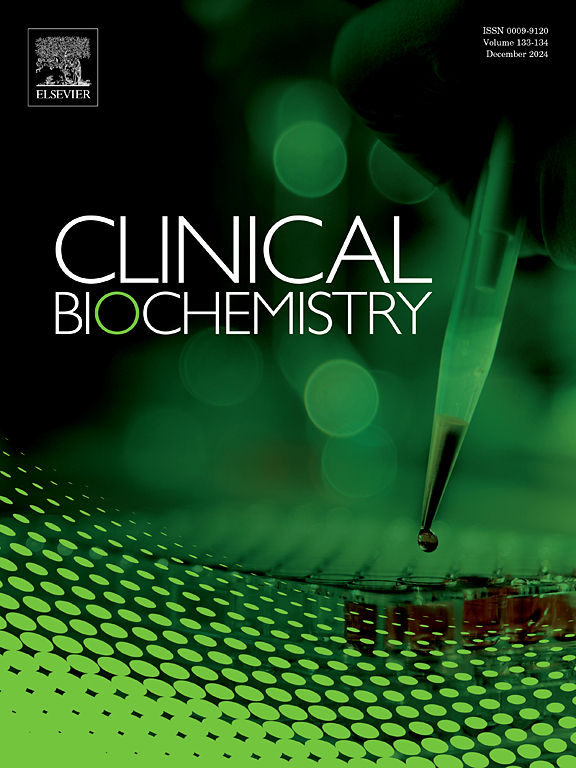静脉乳酸作为急性肺栓塞患者风险分层的工具:一项回顾性队列研究
IF 2.1
3区 医学
Q2 MEDICAL LABORATORY TECHNOLOGY
引用次数: 0
摘要
肺栓塞(PE)的预后是至关重要的,因为临床严重程度的范围很广,生物标志物如动脉乳酸被认为是疾病严重程度的有用标志物。静脉乳酸更容易获得,但其在急性PE中的预后价值尚未得到广泛评价。我们的目的是确定静脉乳酸水平预测PE患者不良结局的最佳临界值。方法:我们对正常血压(收缩压)进行回顾性研究;100 mmHg),影像学证实PE严重到需要肺栓塞反应小组(PERT)激活,并在激活后24小时内临床测量静脉乳酸。数据是从一个单一的三级学术医疗中心正在进行的PERT患者登记中提取的。主要终点是临床恶化,由7天内发生的综合临床事件定义,包括死亡、导管干预、全身溶栓、体外膜氧合(ECMO)或插管。我们进行了受试者工作特征(ROC)曲线分析,计算了曲线下面积(AUC),并利用与(0,1)的最小距离计算了最佳截止值。结果145例患者纳入最终分析。平均年龄64岁,女性61例(43%)。36例患者(26%)达到了综合结果。ROC曲线的AUC为0.56,静脉乳酸的最佳临界值为1.8 mmol/L,敏感性为58%,特异性为61%。结论在一组血压正常的重症急性肺泡患者中,静脉乳酸水平与急性肺泡恶化无显著相关性。我们的研究结果不支持使用静脉乳酸来预测严重到足以激活PERT的PE患者的临床恶化。本文章由计算机程序翻译,如有差异,请以英文原文为准。
Venous lactate as a tool for the Risk-Stratification of patients with acute pulmonary embolism: A retrospective cohort study
Introduction
Prognostication in pulmonary embolism (PE) is crucial due to the broad range of clinical severity, and biomarkers such as arterial lactate are considered helpful markers for illness severity. Venous lactate is more readily accessible, but its prognostic value in acute PE has not been widely evaluated. We aimed to determine optimal cutoffs for venous lactate in predicting adverse outcomes in patients with PE.
Methods
We performed a retrospective study of normotensive (systolic blood pressure > 100 mmHg) patients presenting with imaging-confirmed PE severe enough to require Pulmonary Embolism Response Team (PERT) activation and a venous lactate measured clinically within 24 h of activation. Data were extracted from an ongoing registry of PERT patients at a single, tertiary academic medical center. The primary outcome was clinical deterioration defined by a composite of clinical events occurring within 7 days, including death, catheter-based intervention, systemic thrombolysis, extracorporeal membrane oxygenation (ECMO), or intubation. We performed a receiver operating characteristic (ROC) curve analysis, calculated the area under curve (AUC), and calculated optimal cutoff value using the least distance from (0,1).
Results
We included 145 patients in the final analysis. Mean age was 64 years and 61 (43 %) were female. 36 patients (26 %) met the composite outcome. The AUC of the ROC curve was 0.56, and the optimal cutoff for venous lactate was 1.8 mmol/L, corresponding to 58 % sensitivity and 61 % specificity.
Conclusion
In a cohort of normotensive patients with severe acute PE, venous lactate was not significantly associated with acute deterioration. Our findings do not support the use of venous lactate for prognostication of clinical deterioration in patients with PE severe enough to warrant PERT activation.
求助全文
通过发布文献求助,成功后即可免费获取论文全文。
去求助
来源期刊

Clinical biochemistry
医学-医学实验技术
CiteScore
5.10
自引率
0.00%
发文量
151
审稿时长
25 days
期刊介绍:
Clinical Biochemistry publishes articles relating to clinical chemistry, molecular biology and genetics, therapeutic drug monitoring and toxicology, laboratory immunology and laboratory medicine in general, with the focus on analytical and clinical investigation of laboratory tests in humans used for diagnosis, prognosis, treatment and therapy, and monitoring of disease.
 求助内容:
求助内容: 应助结果提醒方式:
应助结果提醒方式:


